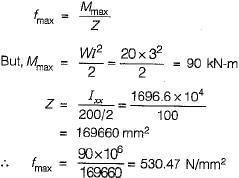Test: Beams - 1 - Civil Engineering (CE) MCQ
10 Questions MCQ Test - Test: Beams - 1
The allowable shear stress in the web of mild steel beam decreases with
where 'h' is height and ‘t is thickness
where 'h' is height and ‘t is thickness
The outstand of the flange of built-up beams from the line of connection should not extend beyond
A cantilever arm is to be attached to a column. Which one among the following is the best connection?
A steel beam is connected to a steel column by means of two angles placed on the two sides of the web of the beam. What is it called?
A cantilever steel beam of 3 m span carries a uniformly distributed load of 20 kN/m inclusive of self-weight. The beam comprises of ISLB200@198 N/m, flange = 100 mm x 7.3 mm; web thickness = 5.4 mm; Ixx = 1696.6 cm4; Iyy = 115.4 cm4. What is the maximum bending stress in the beam?
Generally the maximum deflection of a steel beam should not exceed
Consider the following statements:
A grillage base is checked for
1. bending
2. shear
3. compression
4. web crippling
Which of these statements are correct?
A steel beam supporting loads from the floor slab as well as from wall is termed as


 for sections and 12t for flats where ‘t is the thickness of the section or flat.
for sections and 12t for flats where ‘t is the thickness of the section or flat.

















